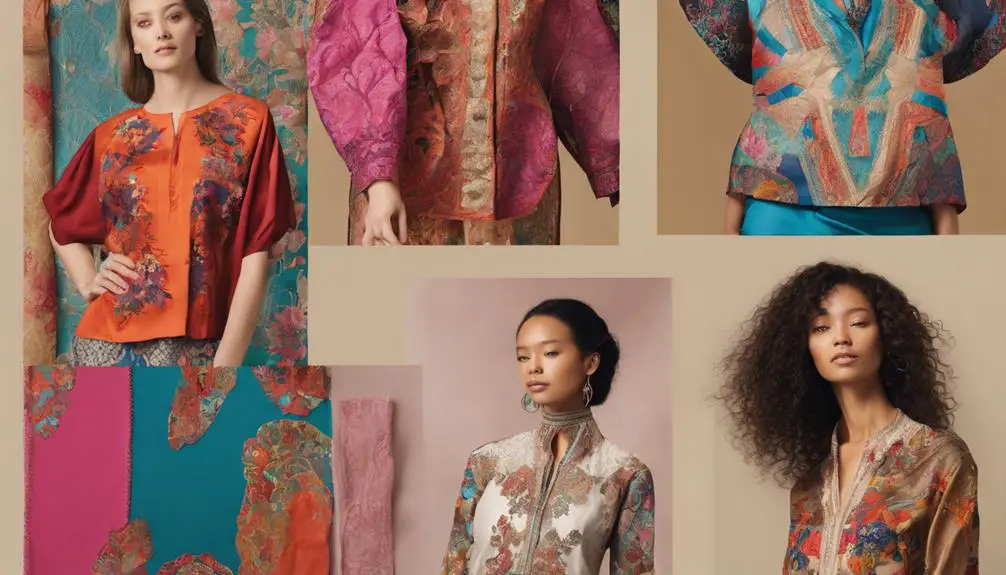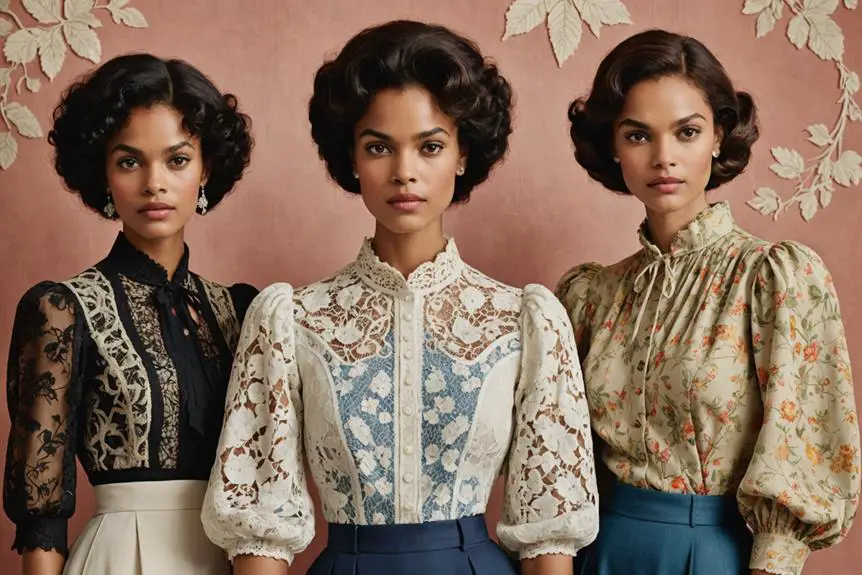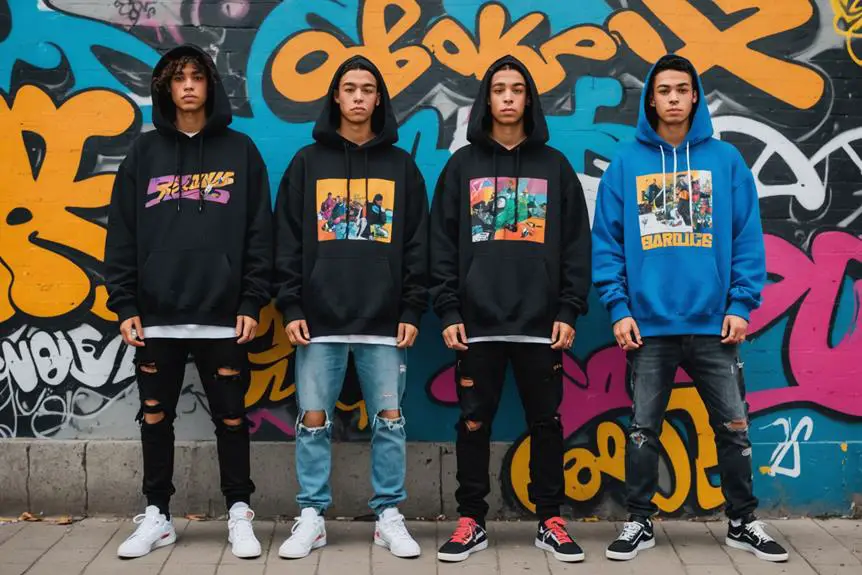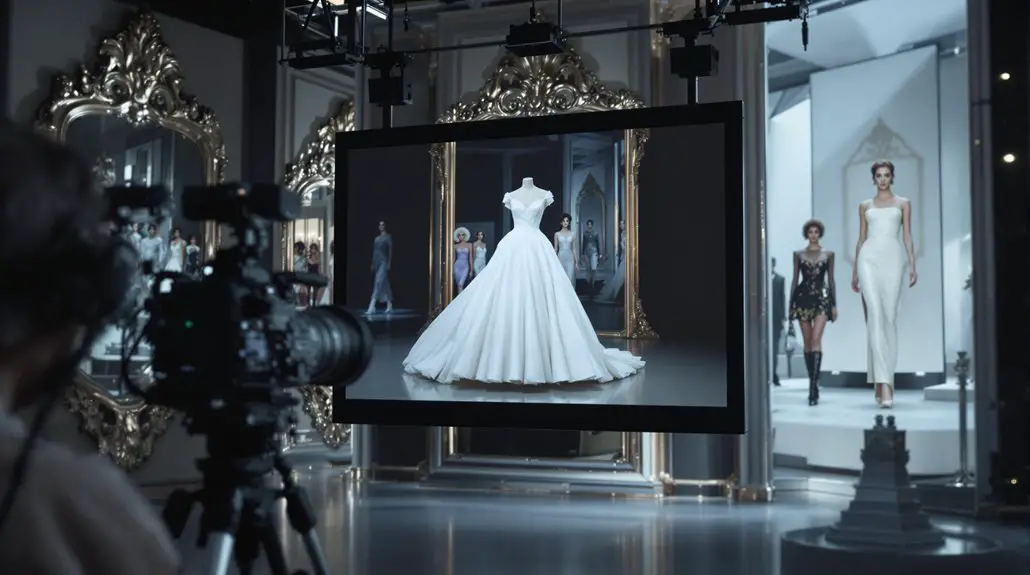Did you know that blouses have been a part of fashion for over two millennia, originally worn by men in ancient cultures? As you explore their transformation from the 6th century B.C. to the present, you'll find that blouses have not only adapted to societal changes but have also mirrored the evolving roles of women. The garment's journey through different eras and styles raises questions about its significance in fashion history. What cultural influences have shaped its design, and how is it responding to modern sustainability trends?
Origins of the Blouse

The blouse has a fascinating history that dates back to the 6th century B.C., showcasing how fashion evolves over time. Can you believe that blouses were once part of a three-piece outfit called Poshak? This ensemble included the Antriya (the lower garment), Uttariya (the veil), and Stanapatta (the chest-band). Initially, blouses were associated with men and unstitched clothing, but that all changed dramatically. Throughout history, various tailoring techniques have transformed the blouse into a versatile garment, allowing for unique styles and fits, such as the chic adjustments made to a Peasant Blouse for better comfort and appeal.
Fast forward to the Victorian Era, and you see significant changes! Blouses became a staple in women's fashion, featuring delicate fabrics and intricate embellishments. It's amazing how the term "blouse" shifted in the late 19th century, moving from just workwear to a fashionable piece embraced by women everywhere.
Now, let's talk about Indian women. The modern saree blouse, which you might see today, emerged in the 19th century. It was influenced by remarkable figures like Jnanadanandini Devi, who cleverly mixed European styles with traditional Indian attire. This fusion shows how different cultures can inspire one another, don't you think?
The history of blouses is rich and colorful, shaped by British colonialism and Mughal culture. These influences helped blouses gain acceptance in women's wardrobes across various cultures. So, next time you slip on a blouse, remember—you're wearing a piece of fashion history that connects you to countless women around the world!
Evolution Through the Ages
As fashion trends shifted, blouses transformed from simple work garments into essential pieces of women's wardrobes. Can you imagine how different styles evolved over the years? The blouse has quite the history! It all began in ancient civilizations, where it was just a loose-fitting garment for workmen. Fast forward to the 1890s, and the blouse started making waves in women's fashion. Vintage clothing enthusiasts often appreciate the craftsmanship of these early designs, especially when identifying quality fabrics used in blouses from different eras, such as recognizing quality fabrics.
One standout style was the Garibaldi shirt from the 1860s, which featured a loose design and vibrant colors. It was a game-changer! Then came the iconic Gibson Girl blouse in the early 20th century. With puffed sleeves and high collars, it became a symbol of feminine fashion, representing social status and elegance.
As we moved into the 1920s, the Art Deco movement took center stage. Blouses became bold, with vibrant colors and geometric patterns, and silk blouses with intricate embroidery were all the rage. By the time we hit the post-World War II era, blouses evolved again. Influenced by Hollywood glamour, they became tailored and versatile. Women were stepping into a new role in society, and their fashion reflected that change.
Even in the Indian subcontinent, blouses took on unique styles, showcasing cultural influences. So, whether you're rocking a classic Gibson girl blouse or a modern silk design, remember that each blouse tells a story! Isn't it fascinating how fashion can connect us to history?
Cultural Influences on Blouse Design

Cultural influences have woven a rich tapestry into blouse design, showcasing the interplay between tradition and modernity. It's fascinating how blouse designs have evolved, isn't it? Take the peasant blouses, for instance. They draw inspiration from traditional Puerto Rican attire, adding a splash of cultural heritage to your wardrobe. Then there's the Indian blouse, which has roots in historical garments like the choli. Vintage fashion pieces, much like blouses, often tell a story of their own, reflecting the unique characteristics of different eras and cultures vintage fashion pieces. Isn't it amazing how fashion tells a story?
When British colonial rule rolled in, it brought Western styles like the blouse and petticoat. These styles contrasted sharply with Indian draped garments, changing how women were seen in public spaces. Blouses have a rich history, reflecting the intricate embroidery and luxurious fabrics that trace back to the opulence of the Middle Ages and Renaissance. You can practically feel the craftsmanship and artistry in every stitch!
The 1920s Art Deco movement also left its mark, introducing vibrant colors and geometric patterns to blouse designs. Cultural exchanges during that time were vital, shaping what we wear today.
Now, modern blouse designs emphasize inclusive fashion, pulling influences from all over the globe. They represent diverse cultures and respond to the global fashion landscape by embracing sustainable practices. So, whether you love long sleeves or chic silk blouses, there's a world of inspiration behind every piece. Isn't it cool to think that every blouse you wear carries a bit of history and culture?
Modern Trends and Styles
Today, contemporary blouse designs frequently showcase an incredible diversity, featuring styles that cater to a variety of fashion aesthetics. You've got button-up blouses that fit perfectly in the office, peasant blouses for relaxed weekends, and off-the-shoulder designs that scream summer fun. With so many different styles, you can easily find something that suits your vibe! As brands adapt to market trends, the evolution of clothing tags helps identify unique vintage pieces, reflecting their rich histories and styles, including those from H&M's branding evolution.
The dress code for women has evolved, and blouses made from fabulous fabrics like cotton, silk, and chiffon let you express yourself in any setting. Whether you're dressing up for a special occasion or keeping it casual, there's a blouse that fits the bill. Plus, thanks to the rise of sustainable fashion, many brands now focus on eco-friendly materials, so you can look good while being kind to our planet.
Social media and influencers have become game-changers in shaping these trends. They make fashion super accessible and help new styles spread like wildfire! And let's not forget about inclusivity in sizing. Designers are now creating blouses that cater to a wider range of body types and backgrounds. Who doesn't want to feel fabulous in something that fits just right?
Sustainability in Blouse Fashion

Embracing sustainability in blouse fashion has become a significant trend that reflects a growing awareness of environmental issues. You might've noticed how more and more brands are switching to sustainable fashion. It's exciting! Designers are now crafting blouses from organic fabrics, like Tencel and organic cotton, which are produced without harmful chemicals. This not only keeps our planet healthier but also gives you a guilt-free wardrobe.
But it doesn't stop there! Fair trade brands are popping up everywhere in blouse fashion. They guarantee that the folks making your clothes earn fair wages and work in safe conditions. That's what we call ethical production, and it's super important. When you buy a blouse from one of these brands, you're not just looking fabulous; you're also making a positive impact.
The movement toward sustainable fashion encourages you to invest in high-quality, timeless designs instead of chasing after fast fashion. Ever bought something you wore once and then forgot about? Yeah, we've all been there! By choosing well-made blouses, you're promoting longevity and reducing waste.
Thanks to social media, it's easier than ever to connect with eco-conscious brands. They're sharing their stories and helping you make responsible purchasing decisions. So why not join the movement? You can look amazing while helping the planet at the same time. It's a win-win!
Frequently Asked Questions
Why Is It Called a Blouse and Not a Shirt?
A blouse reflects its origins in women's fashion, showcasing diverse styles, fabrics, and trends. Its fit and decorative elements symbolize femininity, emphasizing cultural significance, while distinguishing it from the more utilitarian shirt.
What Is the History of Peasant Blouses?
Ever wondered how a peasant blouse evolved? Its origins reflect rich cultural significance, showcasing diverse fabric choices and embroidery styles. With regional variations and modern adaptations, it continues shaping fashion trends today, blending history and contemporary flair.
What Does Blouse Mean in America?
In America, a blouse means a versatile women's top that showcases fashion evolution. You'll find diverse style variations reflecting seasonal trends, influenced by celebrity choices and cultural significance, with various textile choices and modern interpretations making it a wardrobe staple.
What Is the History of the Gibson Girl Blouse?
The Gibson Girl blouse represents a pivotal moment in fashion evolution, blending 1900s styles with women's clothing. Its design variations showcased cultural significance, influencing iconic trends and empowering women to embrace new identities and self-expression.





Amaz?ng blog! Is your theme custom made or did you download it from somew?ere?
A design like yours with a few simple adjustements would
real?y make my bl?g stand out. Please let me know wher? you
got your design. Thanks a lot